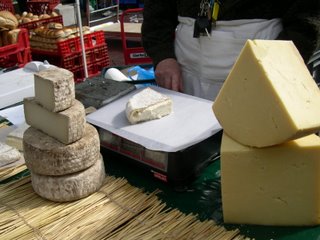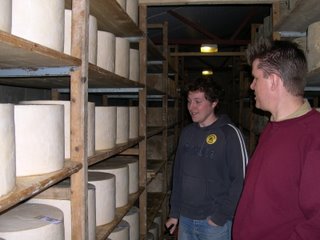
Back to cheese talk.
Most folks don't think about the history behind that block of shrink-wrapped, orange cheese they just brought home from the supermarket. Cheddar originated in Somerset County in England's West Country. There is a town called Cheddar which is close to the Cheddar Gorge and the Cheddar Caves (not much cheese is made in cheddar anymore but there is a touristy museum in the caves.) When you make cheddar, you must cheddar your curds. This is a process of stacking up your curds into loaves and letting the heat that they generate aid in the whey expulsion and acid production. Every ten minutes or so, you flip your curd loaves and let the top part cool and redistribute the moisture. The curds are knitting themselves into a texture like cooked chicken breast. After you cheddar your curds, you must mill them.
A couple of weeks ago, I was slinging the cheese back at La Lecheria de las Vaqueras and what should I spy, but a lone piece of my favorite cheddar on the planet. We had Westcombe Cheddar! Hallelujah! After I wiped my silly grin off of my face I had to ask everyone behind the counter if they had sampled this little beauty. It is one of the BIG THREE traditional farmhouse Somerset cheddars. The others are Keen's and Montgomery's cheddar. Each cheddar has its unique signature flavor, and is as individual as my three cats' personalities. All three are aged at least 18 months before we see them over here. I love Westcombe because it's has a slightly dry, crumbly texture and sweet toffee notes, even hints of butter brickle, yet it's still savory and warm on the tongue. I brought a sliver home and shared it with Jim. He was as thrilled as I was to see it. Together, we broke off a piece to taste. He took a sniff. Then he popped it into his mouth. "Oh my God!" he crooned. "It smells and tastes just like their aging room! I'm transported right there, to that huge room again!" It's true. You could totally smell that moldy, humid, cavernous warehouse in Somerset. This is a good thing.
Jim and I visited Westcombe in May. Tom Calver spent half a day with us, showing us their facilities and the family farm. His dad runs the dairy while Tom takes care of the marketing end of the business. Tom was a superb host. We watched Bob, their cheesemaker preparing to make another batch of cheddar. Tom explained how they incubate a mother culture overnight to get a better starter for their cheese. This culture looks like yogurt when its ready to go. According to Tom, they even eat it like yogurt occasionally. He brought us into their aging room which is a three story bunker filled with thousands of wheels of cheddar and Westcombe Red, a raw milk red Leicester. The smell was of earth, mold, and cheese. Tasting that bite of Westcombe brought us right back to this room. The care and nurturing that these cheeses go through really impressed me. It begins with the cows. Tom wanted to show us something. We piled into his Mitsubishi SUV and drove up to the summit of a high hill. We got out of the car and were swept away by both the blustery wind and the panoramic view that encompassed miles of southern Somerset. In the distance was the Glastonbury tor, farms, small clusters of houses, the village of Evercreech, and his family's own farmhouse. But he wasn't just showing us the very impressive view. It was what we were standing in. All around us was knee high rye grass being tossed by the wind. Tom bent down and plucked a stalk. He told us that it's at its peak in nutrients and energy right now and is ready to harvest but they can't in because it has been too wet. It's true, it was raining a lot. This energy packed rye grass as well as the grass from the pastures helps the cows produce high quality milk. This in turn makes a damn, fine cheese. The care the cheese gets in the aging room, just seals the deal. I knew I liked their cheese, but after a day with Tom and his family, I LOVED their cheese. It's a reflection of their care and concern to make the best cheese that they can produce.
Wednesday, August 16, 2006
Cheddar is a verb
Posted by
Sairbair
at
7:34 PM
![]()
Subscribe to:
Post Comments (Atom)

1 comment:
Great post, I , too, love their cheese, knew nothing of the actual farm thank you SOOOO much for sharing your photos!
Post a Comment